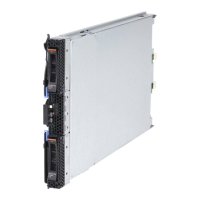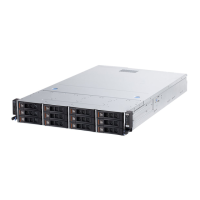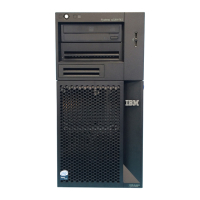Chapter 3. Virtualization 79
Physical memory assigned to partitions are in increments of LMB.
The POWER Hypervisor provides the following types of virtual I/O adapters:
Virtual SCSI
Virtual Ethernet
Virtual Fibre Channel
Virtual (TTY) console
Virtual I/O adapters are defined by system administrators during logical partition definition.
Configuration information for the adapters is presented to the partition operating system.
Virtual SCSI
The POWER Hypervisor provides a virtual SCSI mechanism for virtualization of storage
devices. Virtual SCSI allows secure communications between a logical partition and the IO
Server (VIOS). The storage virtualization is accomplished by pairing two adapters: a virtual
SCSI server adapter on VIOS and a virtual SCSI client adapter on IBM i, Linux, or AIX
partitions. The combination of Virtual SCSI and VIOS provides the opportunity to share
physical disk adapters in a flexible and reliable manner.
Virtual Ethernet
The POWER Hypervisor provides an IEEE 802.1Q VLAN-style virtual Ethernet switch that
allows partitions on the same server to use a fast and secure communication without any
need for physical connection.
Virtual Ethernet support starts with AIX Version 5.3, or the appropriate level of Linux
supporting virtual Ethernet devices (see 3.3.8, “Supported PowerVM features by operating
system” on page 98). The virtual Ethernet is part of the base system configuration.
Virtual Ethernet has the following major features:
The virtual Ethernet adapters can be used for both IPv4 and IPv6 communication and can
transmit packets with a size up to 65408 bytes. Therefore, the maximum MTU for the
corresponding interface can be up to 65394 (=65408 -14 for the header) in non-VLAN
case and to 65390 (=65408-14- 4) if VLAN tagging is used).
The POWER Hypervisor presents itself to partitions as a virtual 802.1Q compliant switch.
The maximum number of VLANs is 4096. Virtual Ethernet adapters can be configured as
either untagged or tagged (following the IEEE 802.1Q VLAN standard).
An AIX partition supports 256 virtual Ethernet adapters for each logical partition. Besides
a default port VLAN ID, the number of additional VLAN ID values that can be assigned per
Virtual Ethernet adapter is 20, which implies that each Virtual Ethernet adapter can be
used to access 21 virtual networks.
Each operating system partition detects the virtual local area network (VLAN) switch as an
Ethernet adapter without the physical link properties and asynchronous data transmit
operations.
Any virtual Ethernet can also have connectivity outside of the server if a layer-2 bridge to a
physical Ethernet adapter is set in one VIOS partition (see 3.3.3, “VIOS” on page 88 for more
details about shared Ethernet). This is also known as a Shared Ethernet Adapter.
Note: Virtual Ethernet is based on the IEEE 802.1Q VLAN standard. No physical I/O
adapter is required when creating a VLAN connection between partitions, and no access to
an outside network is required for inter-partition communication.

